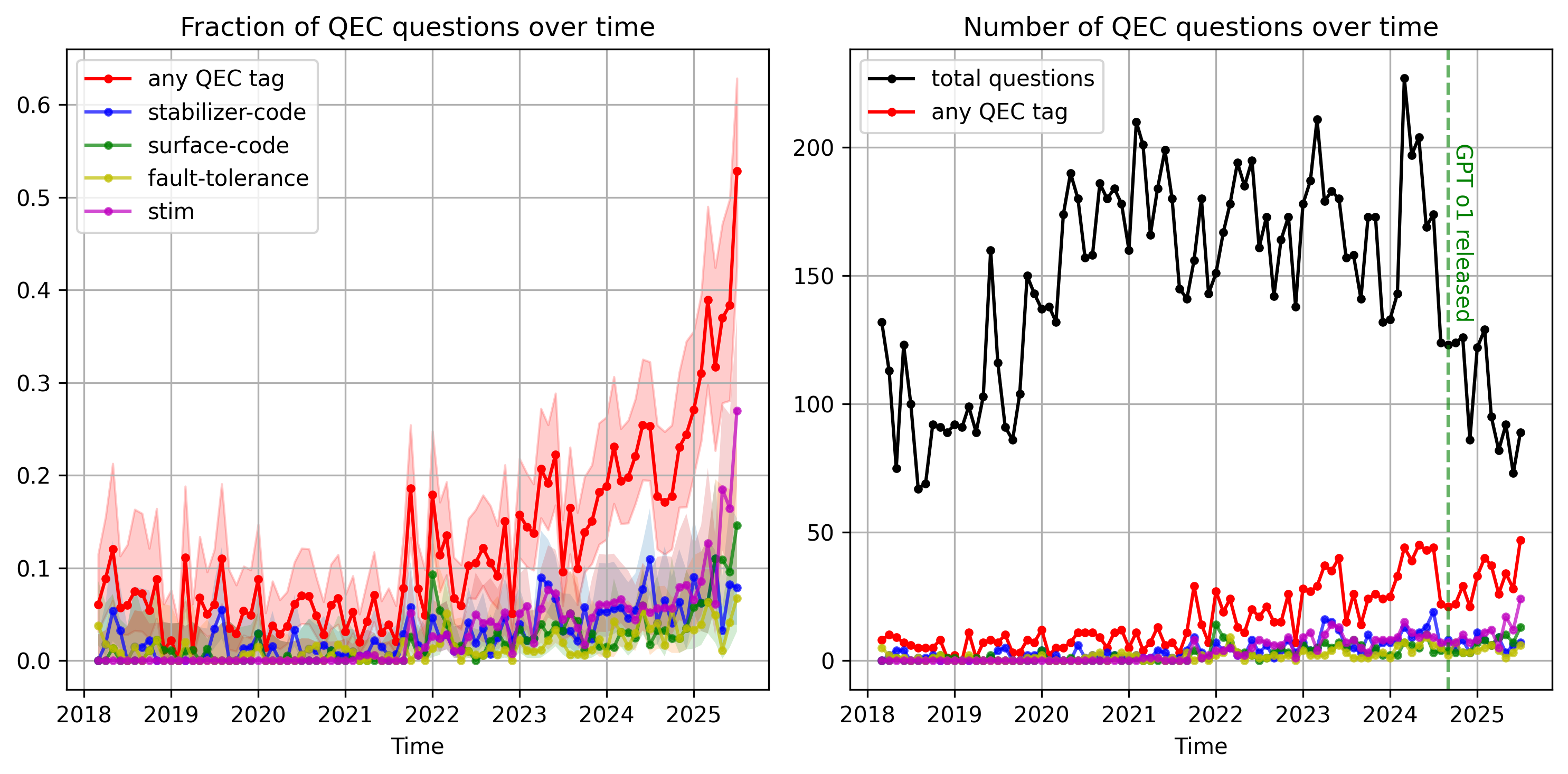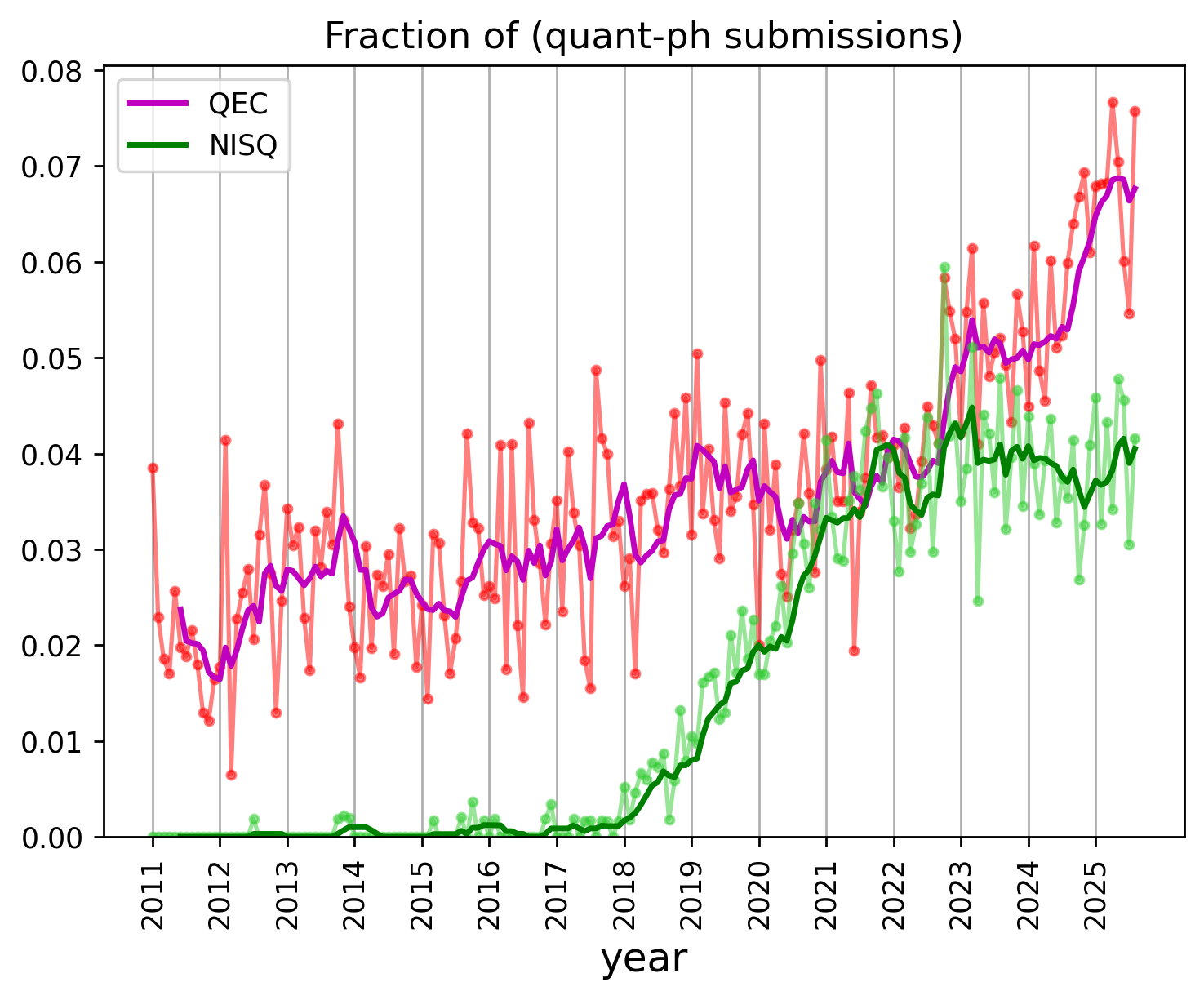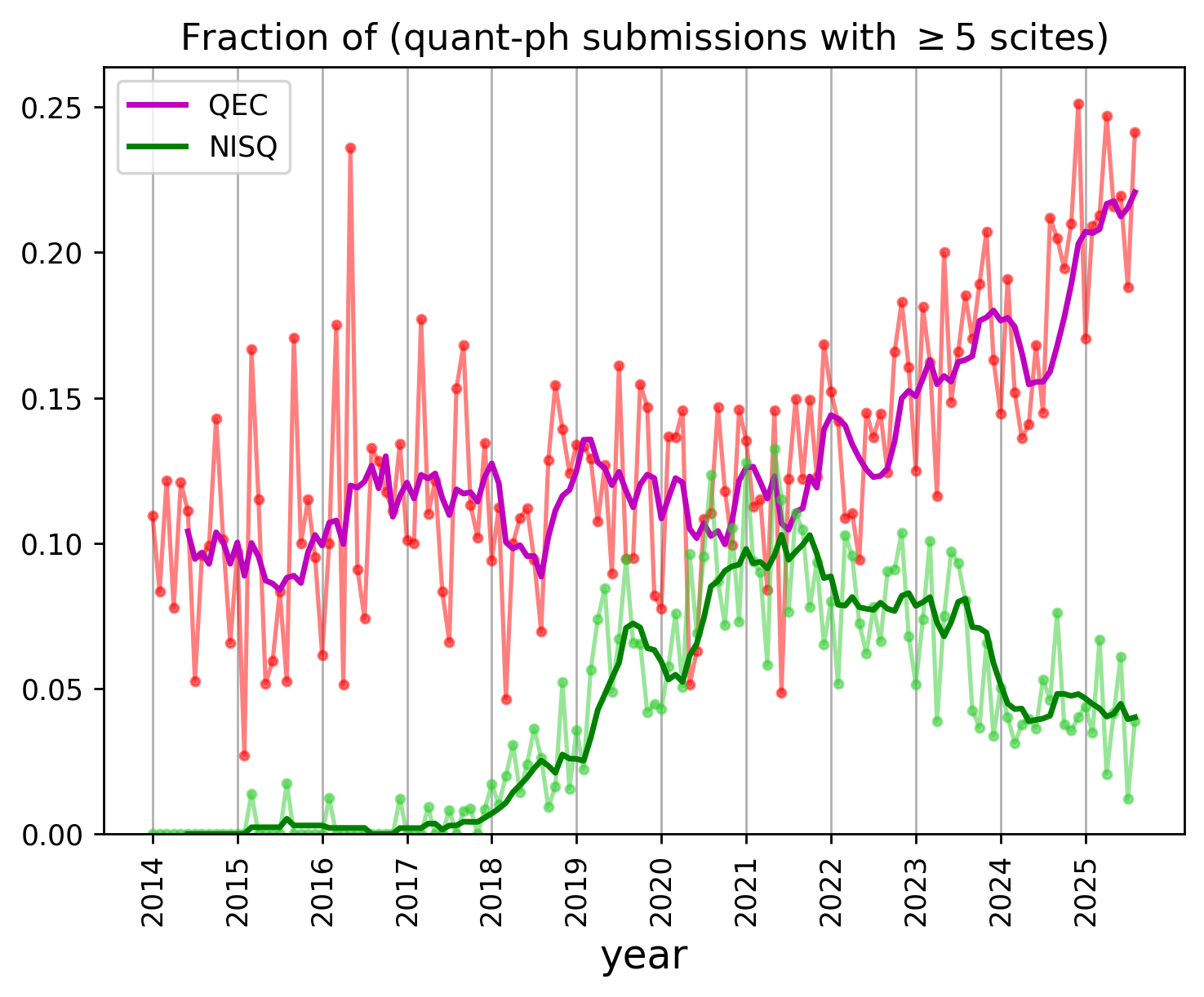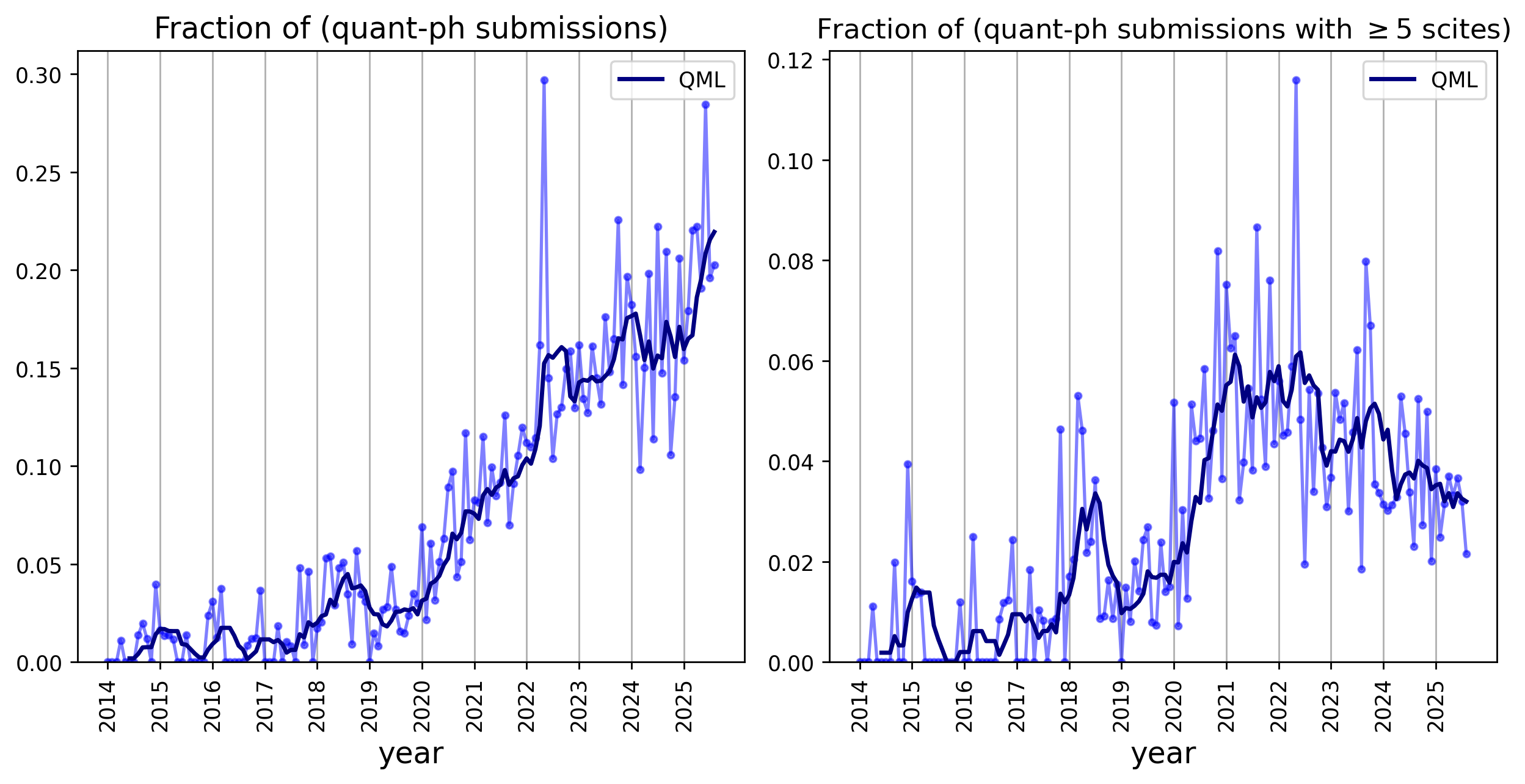Is QEC eating quantum?
Quantum error correction (QEC) is a hot research topic among quantum computing researchers. This is a short analysis of just how popular QEC is.
QEC eats QCSE?
Quantum Computing Stack Exchange (QCSE) is a Q&A site for quantum information topics. Here we see more evidence of a shift in interest towards QEC, as reflected by trends in QCSE questions. Last month, for the first time ever, over half of the questions asked on QCSE were quantum error correction! Is this more evidence that interest in QEC displaced a broader curiousity about quantum computing?
Not really. Instead, the overall user base of QCSE is fleeing, while the number of QEC questions is holding strong. This is driven in part by a steady stream of questions about stim, a software library for simulating QEC whose creator - Craig Gidney - is very helpful and prolific on QCSE.
If we categorize questions according to their tag (indicates what the question topic is), we find a steep increase in QEC-related tags (left). But this hides a huge drop in the total number of user questions (right):
 The average fraction of questions with a QEC-related is approaching 50% (shading reflects the confidence interval assuming a Binomial distribution, just to give an impression of variance). Total QCSE usage has been trending downward in the last 12 months, but there’s still a steady stream of QEC interest.
The average fraction of questions with a QEC-related is approaching 50% (shading reflects the confidence interval assuming a Binomial distribution, just to give an impression of variance). Total QCSE usage has been trending downward in the last 12 months, but there’s still a steady stream of QEC interest.
The drop in questions coincides with the o1 GPT model being released. This makes sense: Reasoning models are usually good at answering basic questions, and even more so when there is a lot of relevant source material available on the internet. But (right now), out-of-the-box AI chatbots are weak at coding tasks involving newer packages (e.g. there’s few code examples to scrape from stackoverflow). So the tag for stim (a popular but recent python package for QEC research) continues to go strong.
This is at least consistent with a trend in research interest towards QEC, but its indirect evidence since we can’t determine how the user base of QCSE divides among researchers versus a broader community of people interested in quantum. To focus on researchers specifically, we can take a look at the arXiv.
QEC eats quant-ph?
If we categorize every quant-ph arXiv submission according to keywords appearing in its abstract+title1, we can get a rough idea of trends in manuscript topics. After assembling a reasonable set of keywords (see Methods) for QEC-related submissions, and also preparing a set of keywords for “noisy intermediate scale quantum” (NISQ), we see this trend:
 The fraction of quant-ph arXiv submissions mentioning quantum error correction (and related topics) is trending upwards, while mentions of NISQ have flattened out.
The fraction of quant-ph arXiv submissions mentioning quantum error correction (and related topics) is trending upwards, while mentions of NISQ have flattened out.
So, publication activity in the area of QEC and fault tolerance is blowing up super-exponentially (a sharp increase in the fraction of an already exponentially growing number of quant-ph). Meanwhile, NISQ has lost a bit of steam (now what are we supposed to do with all these noisy uncorrected qubits?). Its great to be forward-looking, but the fantastic growth rate of research in QEC leaves me wondering - what research comes after quantum error correction? For example, I strongly suspect that classical error correction makes up only a tiny fraction of computer science research today.
While counting quant-ph submissions is a decent proxy for what researchers are interested in and spending time on, it doesn’t tell us whether QEC is cool.
QEC eats Scirate?
Scirate is an online popularity contest online platform that lets people upvote and comment on arXiv submissions2. It is used almost exclusively by the quantum computing research community. Usage of scirate is growing rapidly, as the number of quant-ph submissions balloons beyond what is easily skimmable in a daily email3. We can see here that QEC-related make up a growing fraction of submissions that get attention on on Scirate4.
 Among papers that get attention (at least 5 upvotes) on Scirate, QEC represents a growing fraction. It is a “cool” subfield.
Among papers that get attention (at least 5 upvotes) on Scirate, QEC represents a growing fraction. It is a “cool” subfield.
Bonus: QML: hot or not?
Out of personal curiousity, I took a look at how QEC compares to another hot subfield, “quantum machine learning” (QML). Even with all the hype that QML has a (bad) reputation for, the growth rate for submissions in this subfield is actually slightly lower than QEC in the same time period! But, as is clear from Scirate, QML papers make up a shrinking fraction of the cool papers.
 The number of QML-related submissions is growing rapidly, but this topic is decidedly `“uncool” as measured by Scirate voters.
The number of QML-related submissions is growing rapidly, but this topic is decidedly `“uncool” as measured by Scirate voters.
Methods
The keywords for categorizing quant-ph submissions are below. Note that these lists are short, so the trend lines can be thought of as lower bounds. Obviously this is a fuzzy matching process and submissions can be cross-disciplinary, so treat these numbers as loose estimates.
QEC hits:
error correct: 3144
error-correct: 1152
logical qubit: 830
fault toleran: 475
stabilizer code: 510
surface code: 751
toric code: 475
qudit code: 11
error detect: 172
quantum code: 651
convolutional code: 40
CSS: 287
color code: 198
parity check: 133
logical gate: 242
logical error: 327
bicycle: 116
cubic code: 21
qec: 8
For NISQ, I’ve used the following barebones keywords. I have not included arguably-NISQ algorithms like VQE and QAOA, because those have sort of become subfields of their own and are not exclusively confined to NISQ devices.
NISQ hits:
intermediate scale: 256
hardware-efficient: 251
intermediate-scale: 1176
error mitigation: 647
nisq: 1424
hardware efficient: 41
zero-noise extrapolation: 70
For QML, I kept things straightforward but with the addition of “barren plateau”, which has a non-negligble effect on the overall trend.
QML hits:
qml: 374
quantum neural network: 564
quantum machine learning: 1265
barren plateau: 307
I used SEDE and ChatGPT for analyzing QCSE trends, the arXiv Kaggle dataset for quant-ph trends, and the scirate API for Scirate trends.
Acknowledgments
I used the scirate API, so thanks to Vincent Russo.
-
The entire metadata for arXiv is available on Kaggle: link ↩
-
Early on there was some debate among people using Scirate, and to this day no one really knows what an upvote on scirate means. I will look into that in a future post. ↩
-
I mean this literally, in the sense that daily arXiv digest emails for
quant-phare now sometimes longer than the email length that gmail is willing to display by default, meaning that some submissions will not even appear in the email unless you exploit arXiv’s ordering system. ↩ -
Its actually really hard to do statistics on Scirate behavior, since upvotes are highly nonstationary (the number of daily Scirate users grows over time) but also have very limited statistics (less than 50ish papers per day with large fluctuations). For example, comparing a submission’s scites to the average number of scites requires computing a moving average with a window that is small enough to reflect a roughly-stationary process but large enough to be meaningful. ↩